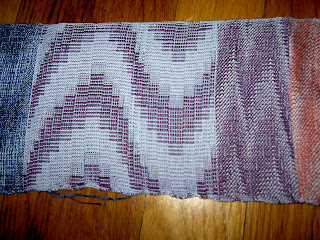After Bonnie Inouye's Advance! workshop, I had plenty of warp left on the loom. I had a lot of breaking ends because, I believe, the tencel warp wasn't getting along with the flat steel heddles on my Baby Wolf. I'd had that issue in the past, but it had been a while, so I kind of forgot about it. Anyway, I didn't want to fight the warp to make a scarf or anything, but it was perfect for weaving more samples.
The warp was 8/2 tencel sleyed at 28 epi. Each of us in the workshop was assinged a different threading. Mine was an extended advancing twill: 1, 2, 3, 4, 1, 2, 3, 4, 1, 2, 3, 4, 5, 2, 3, 4, 5, 2, 3, 4, 5, 2, 3, 4, 5, 6, etc... I enjoyed this threading because each pattern had a large scale. That was one of the points that Bonnie tried to make, that it's nice to be able to see that a textile is interesting from across the room. Below I'll show the samples that I wove, both during the workshop and at home.
The first sample, below, is tromp as writ, with wide bands of color moving diagonally across the sample.

The next sample, below, starts out with a regular 5 pick advancing treadling. Then I moved to an extended advancing treadling, and you can see the slope of the lines change. Then I reversed the treadling, and you can see mirror symmetry at those points.

The next sample below shows an advancing and descending treadling. Here, you can see the slope of the lines reverse, but the twill continues without the mirror symmetry seen above.

The next sample below shows an advancing point treadling. This one was a lot of fun. It was really easy to change the slope and the direction of the lines.

This sample shows an overshot treadling. For the tabby weft, I used Bambu12 in a color that blended with the warp. The pattern weft was 8/2 tencel. Here I played a little, trying to get some curves. I had my for the other samples, I had the treadles tied in a walking format, so I decided to re-tie the treadles for this overshot sample so that the tabby treadles would be next to each other. After I was done with this sample, I figured out that one of my pattern treadles was tied up wrong.

This sample is the last one I wove during the workshop. It has a network treadling. At the beginning of the sample (the left in this picture), I used the treadling that Bonnie gave us in her workbook. Toward the right, I treadled freestyle, using a technique that Bonnie explained in her lecture. I started to get the hang of it, but to be able to create curves that really look good, I'll definitely need some practice.

This sample, I wove at home after the workshop. I wove all of this freestyle, using the techniques that Bonnie taught. The far left, light blue, is a combination of advancing and extended advancing treadlings, which changes the slope of the diagonal lines. The middle sample, dark blue, is an overshot treadling. The tabby weft in this sample is rayon chennile, and the pattern weft is the Bambu 12 that I used as tabby weft in the overshot above. The effect was very subtle, and the sample looks nicer from a distance than it does close-up, which is shown in the next photo.


The sample below shows overshot with Bambu 12 tabby weft and 8/2 tencel as pattern weft. To the right, I played some more with advancing and decending treadling. I need to study this a little more since I understand the basics, but something about it hasn't quite clicked. I think I'll understand it more if I continue to play with it.
Finally, the last sample, on the right, shows network treadling. I'm starting to get a better feel for this, but, again, it will take some more practice to really get the hang of it and create some nice curves while I'm at the loom.
At our guild meeting this weekend, we all brought our samples from the workshop for show-and-tell for the other members. One thing that stuck out to me after our discussion was how many of the samples (mine and others) looked better from across the room than they did close-up. As people across the room would hold up their samples, I thought, wow! Then, as they were passed around and came to me, I thought, well, that's interesting, but I don't love it. That wasn't the case for all of the samples, but for some. This is something I'm definitely going to play with more and practice, to see what I like best, and how to use it best.















